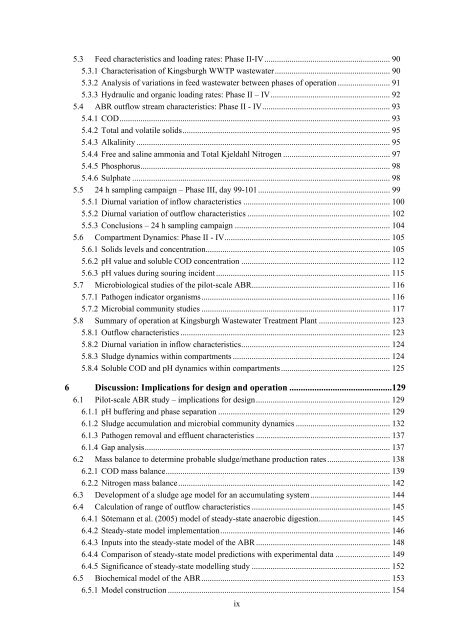analysis of a pilot-scale anaerobic baffled reactor treating domestic ...
analysis of a pilot-scale anaerobic baffled reactor treating domestic ...
analysis of a pilot-scale anaerobic baffled reactor treating domestic ...
Create successful ePaper yourself
Turn your PDF publications into a flip-book with our unique Google optimized e-Paper software.
5.3 Feed characteristics and loading rates: Phase II-IV ............................................................ 90<br />
5.3.1 Characterisation <strong>of</strong> Kingsburgh WWTP wastewater ....................................................... 90<br />
5.3.2 Analysis <strong>of</strong> variations in feed wastewater between phases <strong>of</strong> operation ......................... 91<br />
5.3.3 Hydraulic and organic loading rates: Phase II – IV ......................................................... 92<br />
5.4 ABR outflow stream characteristics: Phase II - IV ............................................................. 93<br />
5.4.1 COD ................................................................................................................................. 93<br />
5.4.2 Total and volatile solids ................................................................................................... 95<br />
5.4.3 Alkalinity ......................................................................................................................... 95<br />
5.4.4 Free and saline ammonia and Total Kjeldahl Nitrogen ................................................... 97<br />
5.4.5 Phosphorus ....................................................................................................................... 98<br />
5.4.6 Sulphate ........................................................................................................................... 98<br />
5.5 24 h sampling campaign – Phase III, day 99-101 ............................................................... 99<br />
5.5.1 Diurnal variation <strong>of</strong> inflow characteristics ...................................................................... 100<br />
5.5.2 Diurnal variation <strong>of</strong> outflow characteristics .................................................................... 102<br />
5.5.3 Conclusions – 24 h sampling campaign .......................................................................... 104<br />
5.6 Compartment Dynamics: Phase II - IV ............................................................................... 105<br />
5.6.1 Solids levels and concentration ........................................................................................ 105<br />
5.6.2 pH value and soluble COD concentration ....................................................................... 112<br />
5.6.3 pH values during souring incident ................................................................................... 115<br />
5.7 Microbiological studies <strong>of</strong> the <strong>pilot</strong>-<strong>scale</strong> ABR .................................................................. 116<br />
5.7.1 Pathogen indicator organisms .......................................................................................... 116<br />
5.7.2 Microbial community studies .......................................................................................... 117<br />
5.8 Summary <strong>of</strong> operation at Kingsburgh Wastewater Treatment Plant .................................. 123<br />
5.8.1 Outflow characteristics .................................................................................................... 123<br />
5.8.2 Diurnal variation in inflow characteristics ....................................................................... 124<br />
5.8.3 Sludge dynamics within compartments ........................................................................... 124<br />
5.8.4 Soluble COD and pH dynamics within compartments .................................................... 125<br />
6 Discussion: Implications for design and operation .............................................129<br />
6.1 Pilot-<strong>scale</strong> ABR study – implications for design ................................................................ 129<br />
6.1.1 pH buffering and phase separation .................................................................................. 129<br />
6.1.2 Sludge accumulation and microbial community dynamics ............................................. 132<br />
6.1.3 Pathogen removal and effluent characteristics ................................................................ 137<br />
6.1.4 Gap <strong>analysis</strong> ..................................................................................................................... 137<br />
6.2 Mass balance to determine probable sludge/methane production rates .............................. 138<br />
6.2.1 COD mass balance ........................................................................................................... 139<br />
6.2.2 Nitrogen mass balance ..................................................................................................... 142<br />
6.3 Development <strong>of</strong> a sludge age model for an accumulating system ...................................... 144<br />
6.4 Calculation <strong>of</strong> range <strong>of</strong> outflow characteristics .................................................................. 145<br />
6.4.1 Sötemann et al. (2005) model <strong>of</strong> steady-state <strong>anaerobic</strong> digestion .................................. 145<br />
6.4.2 Steady-state model implementation ................................................................................. 146<br />
6.4.3 Inputs into the steady-state model <strong>of</strong> the ABR ................................................................ 148<br />
6.4.4 Comparison <strong>of</strong> steady-state model predictions with experimental data .......................... 149<br />
6.4.5 Significance <strong>of</strong> steady-state modelling study .................................................................. 152<br />
6.5 Biochemical model <strong>of</strong> the ABR .......................................................................................... 153<br />
6.5.1 Model construction .......................................................................................................... 154<br />
ix
















